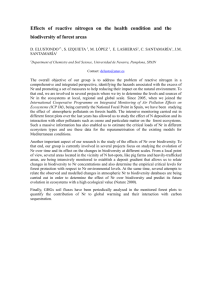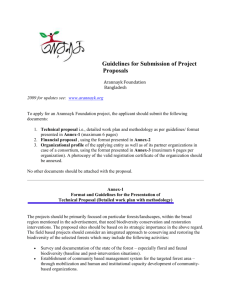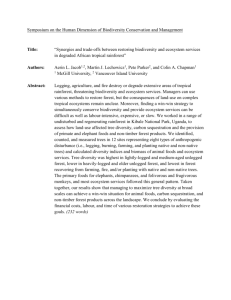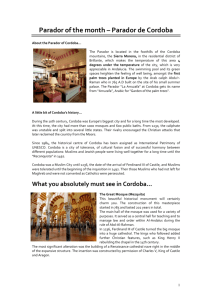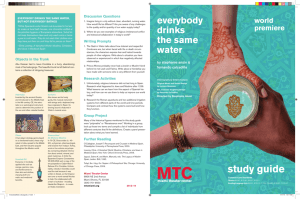Detailed Final Report
advertisement
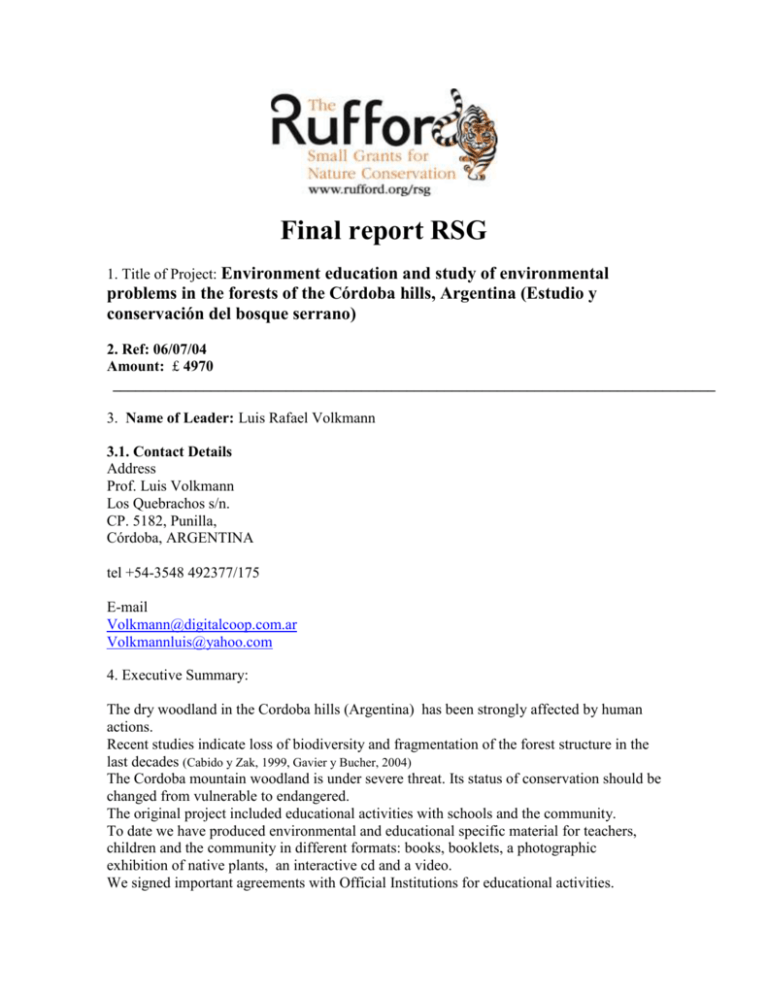
Final report RSG 1. Title of Project: Environment education and study of environmental problems in the forests of the Córdoba hills, Argentina (Estudio y conservación del bosque serrano) 2. Ref: 06/07/04 Amount: £ 4970 ________________________________________________________________________________ 3. Name of Leader: Luis Rafael Volkmann 3.1. Contact Details Address Prof. Luis Volkmann Los Quebrachos s/n. CP. 5182, Punilla, Córdoba, ARGENTINA tel +54-3548 492377/175 E-mail Volkmann@digitalcoop.com.ar Volkmannluis@yahoo.com 4. Executive Summary: The dry woodland in the Cordoba hills (Argentina) has been strongly affected by human actions. Recent studies indicate loss of biodiversity and fragmentation of the forest structure in the last decades (Cabido y Zak, 1999, Gavier y Bucher, 2004) The Cordoba mountain woodland is under severe threat. Its status of conservation should be changed from vulnerable to endangered. The original project included educational activities with schools and the community. To date we have produced environmental and educational specific material for teachers, children and the community in different formats: books, booklets, a photographic exhibition of native plants, an interactive cd and a video. We signed important agreements with Official Institutions for educational activities. We also proposed to implement a study on the effects of fires in the forest and the best methods of restoration and reforestation. Presently we have four field sites reforested, and we have recorded initial data on the field. We supported a research on pregermination seed of a native tree species (Fagara coco). 5. Educational activity outputs: We produced and distributed: a) “Cuentos para chicos” (55 pages), a book for children that includes five different booklets: “Hugo el orugo”, “Telma la vizcacha”, “Pancho el reflexivo”, “Pepe el naturalista en el bosque serrano” and “En defensa de las arañas”. b) “El mundo de lo pequeño” (45 pages), a miniguide of native arthrophods, useful for observing, finding and describing the minor fauna of the mountains. c) A special booklet of the Andean Condor for children. d) Two guides for teachers, (“Manual para docentes”, “Biodiversidad en las Sierras Grandes”) about biodiversity in the Cordoba hills, each one with full information, draws, maps and pictures (A4 format, 34 pages and 4 color illustrations the fist guide, 18 pages and 4 color illustrations the second one) e) A guide for teachers and the community “La protección del bosque serrano, comentarios sobre su importancia, problemas y acciones para su conservación” (A4 format, 15 pages) with comments about the forest characteristics and significance, as well as conservation measures. f) RSG sponsored -contributing with information and photos- the publication of “Biodiversidad y acciones para conservarla, VI Jornadas de ambiente y turismo Los Cocos”, a pocket book distributed in a Training Journey for the Community. g) An interactive cd, including tales, full information, photos and video of the Cordoba hills. h) A video about Biodiversity of the Cordoba hills (a digital master, 20´duration). It includes panoramic shots, basic information about biodiversity and examples, the importance of the biodiversity and the loss and degradation of the environment as a result of human actions. It includes comments on possible solutions as well as opinions and suggestions from several specialists: Dr. E. Bucher, Dr. M. Cabido, Dr. D. Renison. i) A photographic exhibition of native plants, ( 22 mural pictures, 43 x 34 cm., including endemic and typical vegetation of the mountains: Clitoria cordobensis, Mutisia castellanosii var. Comechingoniana, Morrenia stuckertiana, etc., usually unknown to people. This exhibition took place in the Casona Municipal, an Official Governamental Institution in Cordoba city, and was visited by students, teachers, children and public in general. j) 10 workshops in schools attended by 378 children. k) RSG supported during 2006, 15 workshops in rural schools with photos and educational materials (guides for teachers, tales for children, etc.). l) More than 200 teachers (and schools) received our educational materials. m) We signed an agreement with “Universidad Libre del Ambiente”, an Official Institution dedicated to environmental education and conservation. This arrangement will make possible the reprint of the guides for teachers, 1500 copies to be distributed in 40 schools and also to students of Biology (Biol. Sergio Miglietta, unilibrecordoba@yahoo.com ) 6. Workfield outputs: 6.1 We selected three sites in the forest, with different stages of perturbation: one of them severely damaged, mingled with exotic vegetation (Rio Ceballos), another one altered by permanent fires and deforestation (Cuesta Blanca) and the last one in a well preserved stage (Capilla del Monte). We reforested each of them with 150 native seedlings and recorded initial data of burned vegetation and survival of species. We expect to collect a lot of information in the next years. The actions were performed in part with the support of Agencia Cordoba Ambiente, which awarded to Ecosistemas argentinos (Non Govermental Institution of which I am a member) the amount of $ 2500 (early £ 975) in 2005, to pay for foil, field equipment and food in Cuesta Blanca and Río Ceballos sites). Preliminary field data show high seedling survival (approx. 90%), slow growth rate and, at least in one site, a species (Lithraea molleoides) slightly affected by the action of herbivores, particularly domestic ungulates. 6.2 We implemented a pilot project of reforestation with native plants in Los Cocos, with 150 seedlings in burned and not burned areas ranging from 1200 to 1450 meters of altitude, comparing growth and survival of the reforested species. Future data recording will help us to know the best methods of reforestation. First record (Augost 2006) shows a seedling survival aproxx. to 85% in control site, and 80% in burned sites. During September 16 th and 22 th, a great forest fire destroyed over 5000 ha. Study area in Los Cocos and seedlings were erased. I will continue reforesting and recording data about regeneration of forest, survival of relict forests and incidece of herbivores. 6.3 We supported a research on pregermination seeds of a native tree on which there is so far no scientific information and no ways to produce significant figures of seedlings for eventual reforestation actions. This species (Fagara coco) is characteristic and dominant in the forest. Preliminary field data recorded show a fast growht rate and high seedling survival. The research included aproxx. 25 individuals and 400 seeds each one, with two pregermination methods. The results suggest the necessity of new experiments that include temperature as a variable in the treatment of seeds. 7. Aditional advances: We produced some educational materials not contemplated in the original project: a) an additional guide for teachers, b) three booklets for children, c) a guide for the community and teachers. d) More educational actions, 18 workshops at schools, talks in schools (supported with Forest Brigade of Los Cocos) and the photographic exhibition of native plants for the community and schools organized in Cordoba Capital (also to be shown in other locations of the Province in a near future) e) We signed a important agreement with an Official Goverment Institution (Universidad Libre del Ambiente) to reprint 1500 copies of the guide for teachers, with an excellent prospect for the rest of educational materials of this project. d) We maintain close contact with foreign researchers who are investigating exotic species in the forest (Heinze Zimmermann, Henrik von Wehrden, Martin Luther Universitat, Germany,heikz@gmx.de ), and with specialists on vegetation and forest conservation (Dr. M. Cabido, Universidad Nacional de Córdoba, Imbiv-Conicet, mcabido@imbiv.unc.edu.ar, Dr. E. Bucher, Centro de Zoología Aplicada, U.N.C., buchereh@uolsinectis.com.ar ) to investigate focal and endemics plants. Luis Volkmann Los Cocos, 25/9/6 Outputs Educational activities and materials Summary of achievements Field work, study of restoration and reforestation of mountain forest Three sites reforested (Cuesta Blanca, Río Ceballos and Capilla del Monte) with 400 native seedlings in total. Significant figures and data on burned areas, survival of seedlings and growth rate of 6 native seedlings. A pilot project of reforestation with 150 species (mainly Fagara coco and Lithraea ternifolia) in Los Cocos forest. A research of seed pregermination tecniques of Fagara coco. 10 workshops in schools, covering 378 pupils. A photographic exhibition of native plants in Cordoba Capital (students, public in general, five schools) Two color guides for teachers about biodiversity of the Cordoba mountains 200 copies of each one. A book of tales for children, including 5 booklets. 400 copies of them. A booklet of Andean Condor for children (150 copies) A pocket book for children to find and identify local arthropods (300 copies) A guide for the community about conservation measures (150 copies) A interactive cd. A video for community and schools, about biodiversity and conservation of the Cordoba hills. Educational materials received by xxx teachers on xxx schools and xxx Official and Non Official Institutions. An agreement with Universidad Libre del Ambiente, to reprint 1500 copies of the guide for teachers in 40 schools.
